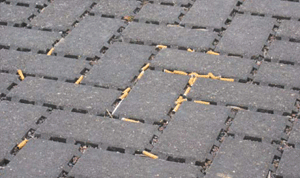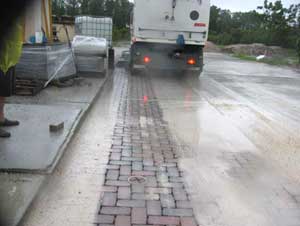Highway Sweeping -- Pitfalls and Safeguards |

Maintenance and Restoration of Porous Pavement Surfaces: An Overview on Current Sweeping Best Practices
by Ranger Kidwell-Ross, based upon an interview and white paper provided by Elgin Technical Consultant, Mark Kinter Porous surfaces have been growing at a double digit rate the last several years as they have increasingly become recognized as a BMP to deal with stormwater runoff. They have been proven to be an effective tool to reduce the quantity of water and accompanying pollutants that are directed untreated to our waterways. However, major questions concerning the maintenance of these surfaces have risen as a result of the growth. Elgin Sweeper Company has been participating in research programs with major universities and municipalities across the U.S. in order to get a better understanding of the maintenance requirements.
This surface can be made of concrete, asphalt, crumbled tire rubber and other materials. When water comes in contact with the upper surface, it flows immediately through the surface to the engineered volume under it. The second is composed of surfaces where the water seeps through pervious gaps between non-pervious blocks. This category is commonly referred to as interlocking blocks that are generally made of concrete. The gaps between the blocks are filled with a granular material that serves to maintain the relative position of the blocks and allow water to seep through. The interlocking blocks are placed on an engineered surface where their spacing is precisely controlled. The gap between the blocks, where the water flows, can vary from 1/8" on the edges to 1" square in the corners to other proprietary shapes. The size of the gap will have a relationship to the tendency to plug. Several studies have shown that either surface type will plug, to varying degrees, with silt, fine clay, cement derivatives, and decomposed plant material. In addition, most studies have shown that on non-traffic areas the plugging is limited to the top half inch or less of the surface. 
The care of these surfaces is divided into two activities: "Elgin is committed to gaining a better understanding of the role of street sweepers in this application," said Kinter. "To that end, we have been actively involved in working with a variety of individuals and organizations to determine BMP techniques for keeping porous pavement clog-free and able to drain well over its usable lifetime." A frequent question is "How long will the surface last before restoration is required?" The answer may seem vague, but it's dependent on the composition of the surrounding soil and the care that landscaping activities exhibit. In certain areas of the country that have very sandy soil, the surfaces will last longer. In areas where there is a high degree of clay in the soil, clogging can occur rather quickly. In fact, installation of porous surfaces in areas of high clay content may not be practical.Since all the surfaces can be plugged by non-attentive behavior, the first step to retaining the porous nature of the surfaces should be to install signs to inform the casual passersby that the surface is indeed porous and that certain activities such as depositing landscape material should be avoided. Prior to cleaning the surfaces, an understanding of the mechanics of street sweepers is required in order to get the most effective use of the equipment and prevent further clogging of the surfaces. This is abbreviated, since most readers will have a solid background in this area. More description is available in the white paper linked further down the page. There are three basic types of sweepers in the U.S. market, mechanical broom machines, which account for 60%-70% of street sweepers, and regenerative air sweepers, which account for about 20%-30% of the total sweeper population, are by far the most popular air-based sweepers n the U.S. Pure vacuum sweepers, although the most popular type of sweeper in Europe, are the least populous in the U.S. They account for only approximately 5% of the U.S. market and only one U.S. company, Elgin Sweeper Co. manufactures a full size vacuum sweeper. Recognition of the increasing niche market of porous pavement is no doubt one factor driving Elgin's sweeping industry leadership role in the porous pavement field. The main advantage of the pure vacuum sweeper? For use on porous pavements it is the high vacuum level of 70"- 80" water they can create. Most porous pavements and many interlocking block surfaces require this degree of vacuum to restore infiltration of a clogged area. Use of water for cleaning: The silt that plugs both types of porous pavement surfaces is generally carried there by water. In a damp condition, the silt swells and has a sticky texture to it. In order to clean the silt out of the pavement, best results are obtained when it's dry enough for the silt to contract and release its grip on the surrounding material. An alternative is to add large amounts of water such that the ratio of water to dirt is very large and use a vacuum sweeper. However, it is difficult to create this situation outside of a heavy rainstorm. A problem with using any of the sweepers mentioned is that they are designed to dampen the surface with a water spray to reduce airborne dust as well as dust and material that is carried through the two types of air sweepers. An alternative on the regenerative and vacuum sweepers is to preload the hoppers with a few hundred gallons of water. 
The water in the hopper effectively eliminates carryover dust through the vacuum fan of either type of sweeper. A downside is that the dumped load contains large amounts of liquid which can create its own issues. Some people feel that high-pressure washing of both types of surfaces is called for. Research indicates that unless the pressure washing is followed up with a vacuum sweeper it is not effective. In addition, the job of pressure washing, without subsequent debris removal, tends to break up surface buildup and simply move it to another location. "Porous pavement installations have been growing at a double digit rate the last few years for stormwater purposes," says Kinter. "The three types, concrete, asphalt and interlocking blocks, each present unique challenges as far as maintenance goes. Elgin has been working with quite a few research facilities the past few years to determine the cleaning and restoration requirements of porous pavements. "We're finally at a point where we feel comfortable with the information we've learned, which is why we are now offering the "white paper" on the subject to clarify the requirements. This subject offers a new and growing market for the contractors that are large enough to afford an Elgin Whirlwind. The reason is that very few of the installations that have the porous surfaces are in a position to maintain them in-house, and most of the installation contractors aren't familiar with the sweeping market. This leaves a great opportunity for contractors. "HOWEVER, keep in mind that, since the nature of the cleaning operation is the removal of silt from subsurface levels, the conventional 'litter gitter sweepers' won't do the job. The market has been wrestling with this situation, where contract sweeping contractors remove litter, but leave dirt behind, for the last few years."
Elgin has also created an environmental component to its website, which is intended to assist people new to the environmental challenges related to sweeping and basin cleaning. As part of its coverage of best practices for sweeping porous pavement, WorldSweeper.com offers an in-depth, 30-minute interview with Elgin Technical Consultant, Mark Kinter, on that topic. To play the interview, click here (will open in a new browser window). If you have any trouble accessing this audio, please let us know.
We would like to acknowledge the following people who contributed to the information provided in this article:
|
© 2005 - 2023 World Sweeper
|
Street Contents
|